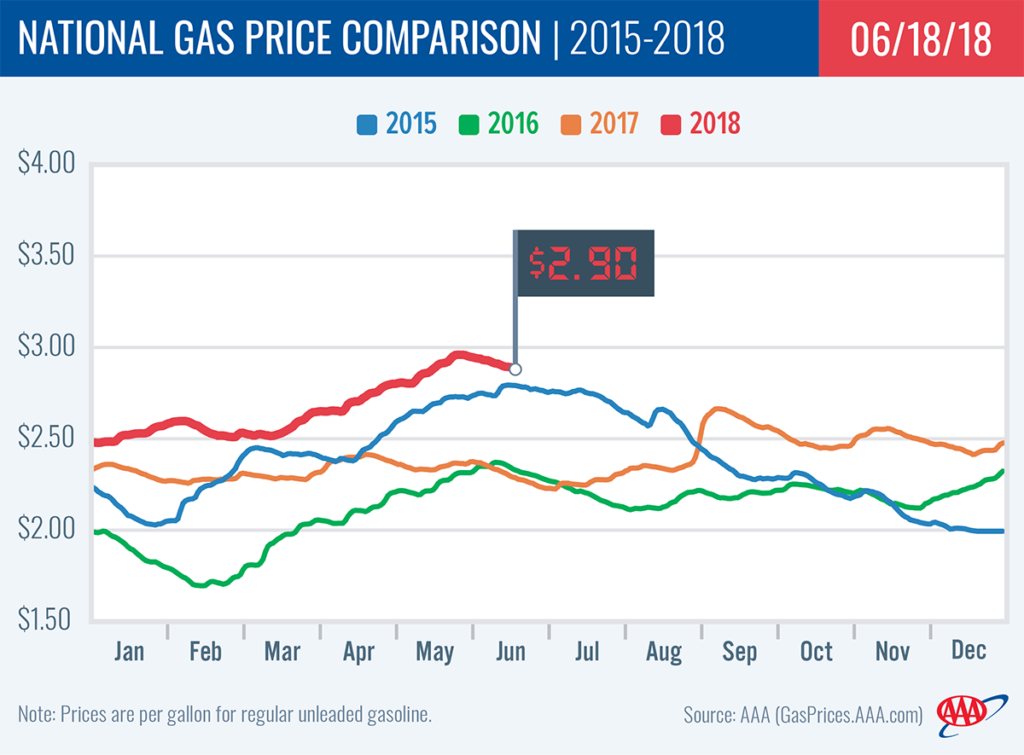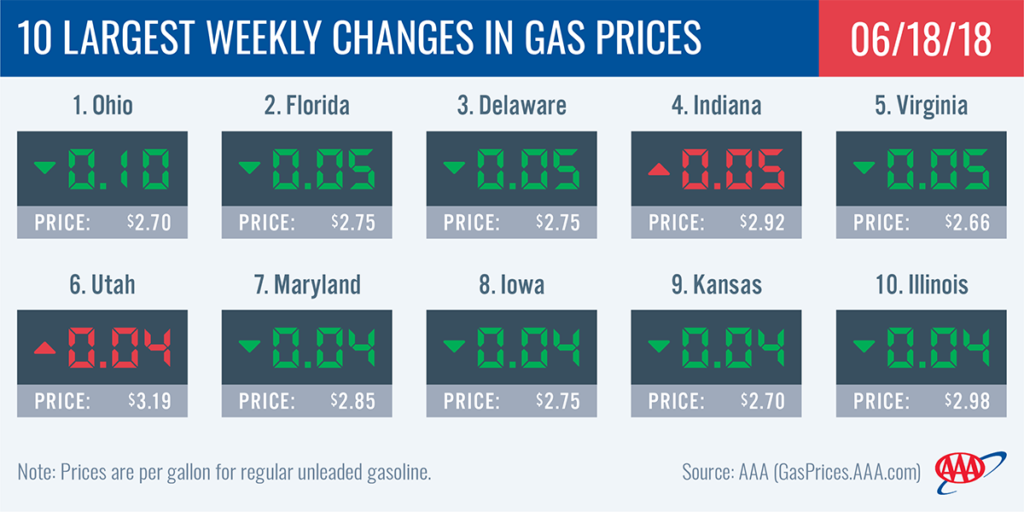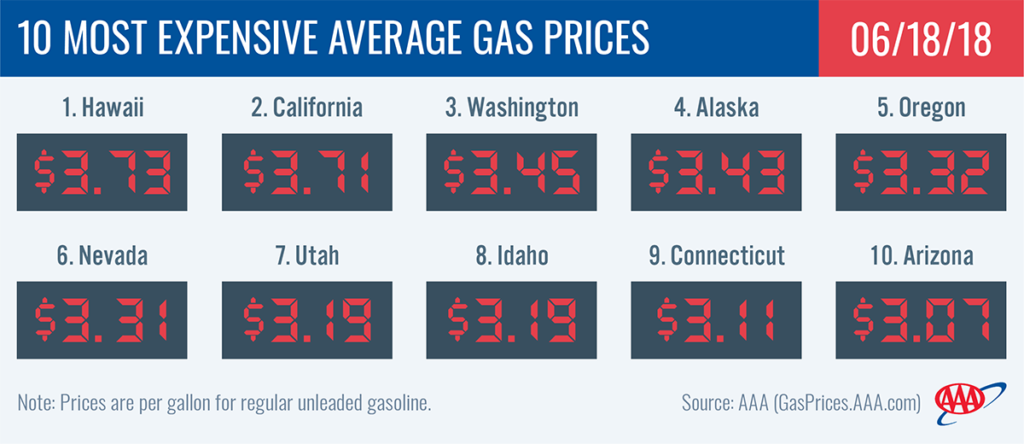On the week, the national gas price average is two cents cheaper at $2.90. Today’s national average is only one cent more expensive than a month ago, but 60 cents more expensive than a year ago.
Nationwide, 44 states have less expensive or steady gas price averages compared to last Monday. However, the cheaper trend may be reversing. Gasoline demand spiked in the latest Energy Information Administration’s (EIA) report, in fact setting a new all-time record at 9.88 million b/d for the week ending June 8. As demand skyrockets, U.S. gasoline inventories plummeted 2.27 million bbl, to land total inventories at 237 million bbl, which is 5.7 million below stocks last year at this time.
“If demand continues to strengthen and inventories decrease in the weeks ahead, motorists can expect gas prices do a reversal and start to increase again,” said Jeanette Casselano, AAA gas price expert. “AAA expects the national gas price average to range between $2.85 and $3.05 through Labor Day, likely seeing the summer’s highest prices in June.”
Moving into this week, another factor that will influence gas prices in the near and long-term will be outcomes from the June 22 OPEC meeting in Vienna, Austria. The cartel, along with other major producers including Russia, will discuss increasing oil production ahead of the year-end scheduled dissolution of its production reduction agreement. Some reports indicate that OPEC could be looking at an increase of 300,000 to 600,000 b/d to help ease global crude price gains that have grown since the cartel put its production reduction agreement into place at the beginning of 2017. An increase in production would likely decrease crude oil prices and encourage cheaper gas prices.
Quick Stats
- The nation’s top 10 most expensive markets are: Hawaii ($3.73), California ($3.71), Washington ($3.45), Alaska ($3.43), Oregon ($3.32), Nevada ($3.31), Utah ($3.19), Idaho ($3.19), Connecticut ($3.11) and Arizona ($3.07).
- The nation’s top 10 largest weekly changes are: Ohio (-10 cents), Florida (-5 cents), Delaware (-5 cents), Indiana (+5 cents), Virginia (-5 cents), Utah (+4 cents), Maryland (-4 cents), Iowa (-4 cents), Kansas (-4 cents) and Illinois (-4 cents).
West Coast
Motorists in the West Coast region are paying the highest pump prices in the country, with all states on the top 10 most expensive list: Hawaii ($3.73), California ($3.71), Washington ($3.45), Alaska ($3.43), Oregon (3.32), Nevada ($3.31) and Arizona ($3.07). On the week, prices continue to mostly decline in the region by a penny or two. However, Hawaii and Alaska each increased by a penny.
According to EIA data for the week ending on June 8, inventories of gasoline grew by 400,000 bbl to reach 31.5 million bbl. Although inventories in the region now sit at their highest level for the second week of June since 2001, ongoing planned maintenance at Shell’s 158,000 b/d Martinez, CA refinery in the Bay area may restrict supplies this week.
Great Lakes and Central
Finding cheaper gas prices at the pump continues this week for the bulk of motorists in the Great Lakes and Central states. Ohio (-10 cents) tops the chart for the biggest weekly change in gas price averages in the country. Also making an appearance on the top 10 changes list: Iowa (-4 cents), Kansas (-4 cents) and Illinois (-4 cents). However, gas prices are more expensive for three states on the week: Indiana (+5 cents), Michigan (+2 cents) and Missouri (+1 cent).
Some states in the region are paying a hefty year-over-year increase. Indiana’s gas price is 80-cents more expensive than last year – the highest of any state in the country and region. Other states at the 55-cent or more mark include Michigan (+70 cents), Illinois (+64 cents), North Dakota (+62 cents), Missouri (+61 cents), Kentucky (+59 cents), Kansas (+58 cents), Wisconsin (+58 cents), Idaho (+57 cents), Ohio (+57 cents), South Dakota (+56 cents) and Minnesota (+56 cents).
Inventory levels bumped up slightly by 300,000 bbl on the week. Levels sit at the 52.5 million mark according to EIA.
South and Southeast
Florida (-5 cents) has the second largest decrease of any state in the country this week. The sunshine state and Georgia carry the most expensive gas price average, $2.77, of all states in the South and Southeast. On the week, state gas price averages are cheaper across the region with Oklahoma seeing the smallest drop at two cents.
For another week, the top six least expensive gas price averages in the country reside in the South and Southeast: South Carolina ($2.55), Mississippi ($2.58), Alabama ($2.58), Louisiana ($2.60), Oklahoma ($2.61) and Arkansas ($2.63).
Falling nearly 1.8 million bbl, the South and Southeast inventory levels dropped to 80 million bbl. However, levels sit just one million below last year at this time, according to EIA data.
Mid-Atlantic and Northeast
Gas prices are one to five cents cheaper across all states in the Mid-Atlantic and Northeast region with Delaware (-5 cents), Virginia (-4 cents), Maryland (-4 cents) and New Jersey (-4 cents) seeing the largest drops on the week. Even with the cheaper pump prices, four states continue to sell gas for $3 or more: Connecticut ($3.11), New York ($3.05), Pennsylvania ($3.04) and Washington, D.C. ($3.01).
Today’s gas prices are 50 to 64 cents more expensive compared to last year at this time with West Virginia seeing the smallest and Connecticut seeing the largest increases year-over-year.
Regional gasoline inventories fell to 65.6 million bbl after a 1.3 million bbl drop on the week. This latest decrease brings the year-over-year deficit for the region to 3.4 million bbl, according to EIA data.
Rockies
On the week, gas prices increased four cents in Utah ($3.19) and a penny in Wyoming ($2.93). Gas prices dropped two cents in Colorado while remaining stable in Montana ($2.95) and Idaho ($3.19). Utah and Idaho continue to carry the most expensive gas prices in the region and among the priciest in the country. The states are the seventh and eighth, respectively, most expensive in the country.
Motorists in the Rockies are paying, on average, 54 to 62 cents a gallon more compared to prices this time last year.
Inventories built by a small 92 bbl on the week. According to EIA data, levels register close to 6.9 million bbl, which is about 680,000 bbl less than this time last year.
Oil market dynamics
At the close of Friday’s formal trading session on the NYMEX, WTI decreased $1.83 cents to settle at $65.06. Oil prices trended marginally higher last week because of a stronger dollar. Looking ahead, this week’s prices will likely see fluctuation ahead of Friday’s OPEC meeting.
According to EIA’s latest weekly petroleum status report, total U.S. production jumped to around 10.9 million b/d, up about 100,000 b/d on the week. However, total crude inventories fell by 4.1 million bbl. Increasing crude exports supported the drop. Last week, exports of crude oil stood at 2.03 million b/d, a week-on-week gain of 316,000 b/d.
Domestic investment in crude production continues to grow. Last week, the U.S. added another oil rig, bringing the current total to 863. When compared to last year’s rig count at this time, there are 116 more active rigs today.
Motorists can find current gas prices along their route with the free AAA Mobile app for iPhone, iPad and Android. The app can also be used to map a route, find discounts, book a hotel and access AAA roadside assistance. Learn more at AAA.com/mobile.



